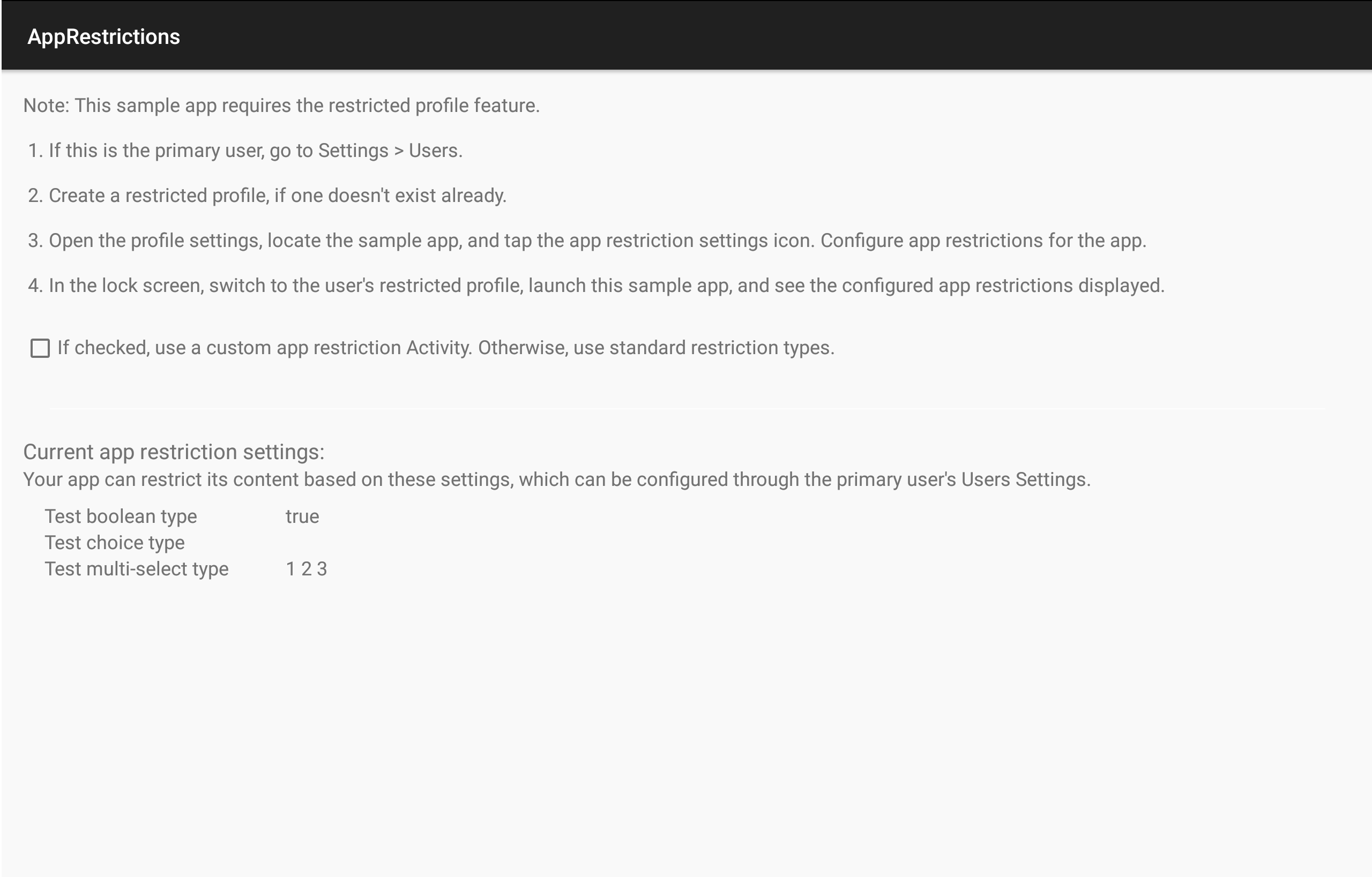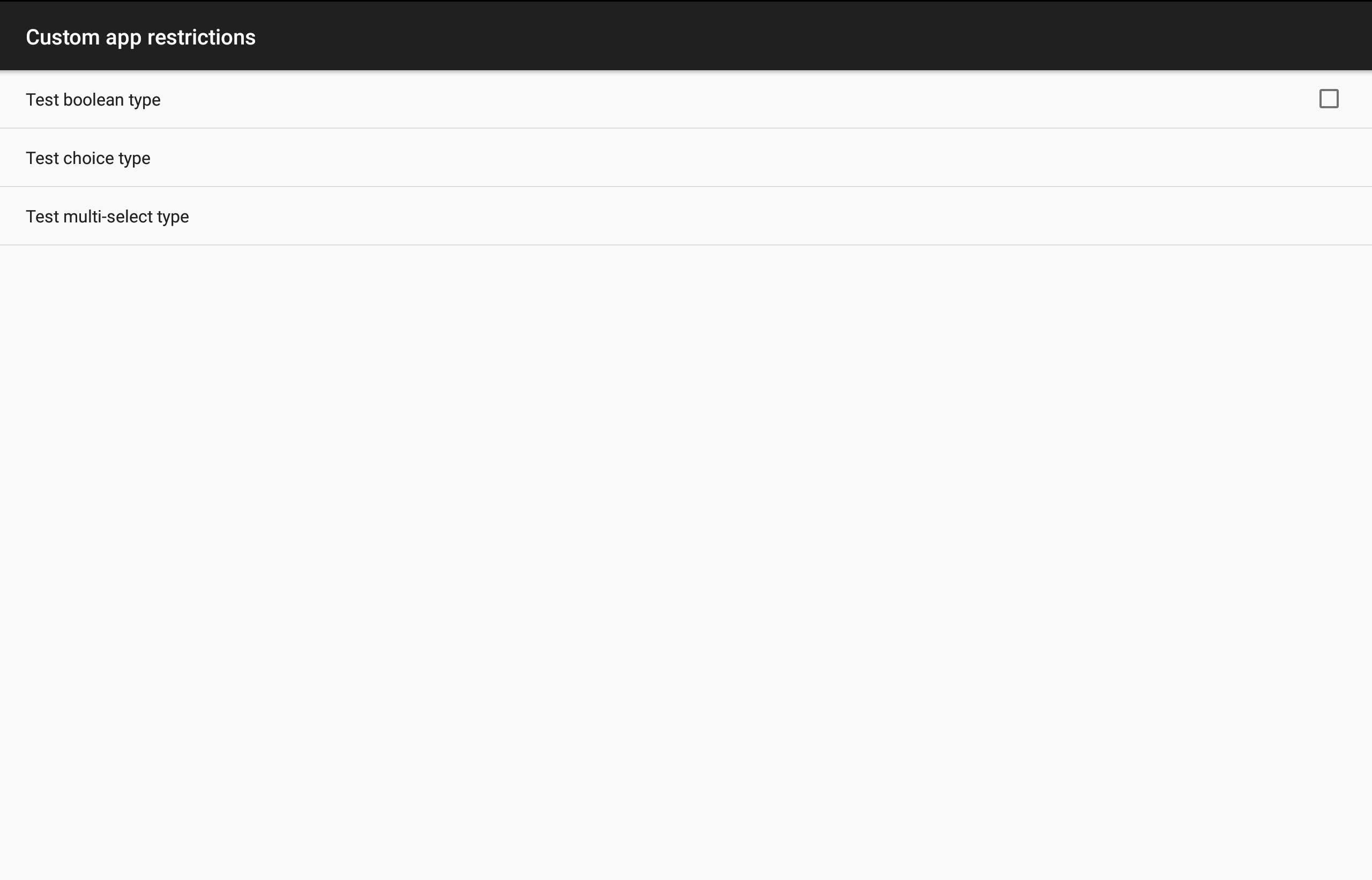Android AppRestrictions Sample
A sample that demonstrates the use of the App Restriction feature on devices with multiuser support
Introduction
This sample demonstrates the use of the App Restriction feature, which is available on Android 4.3 and above tablet device with the multiuser feature.
When launched under the primary User account, you can toggle between standard app restriction types and custom. When launched under a restricted profile, this activity displays app restriction settings, if available.
This sample app maintains custom app restriction settings in shared preferences. When the activity is invoked (from Settings > Users), the stored settings are used to initialize the custom configuration on the user interface. Three sample RestrictionEntry types are shown: checkbox, single-choice, and multi-choice. When the settings are modified by the user, the corresponding restriction entries are saved, which are retrievable under a restricted profile through the UserManager.
Pre-requisites
- Android SDK 26
- Android Build Tools v26.0.1
- Android Support Repository
Screenshots


Getting Started
This sample uses the Gradle build system. To build this project, use the "gradlew build" command or use "Import Project" in Android Studio.
Support
- Google+ Community: https://plus.google.com/communities/105153134372062985968
- Stack Overflow: http://stackoverflow.com/questions/tagged/android
If you've found an error in this sample, please file an issue: https://github.com/googlesamples/android-AppRestrictions
Patches are encouraged, and may be submitted by forking this project and submitting a pull request through GitHub. Please see CONTRIBUTING.md for more details.
License
Copyright 2017 The Android Open Source Project, Inc.
Licensed to the Apache Software Foundation (ASF) under one or more contributor license agreements. See the NOTICE file distributed with this work for additional information regarding copyright ownership. The ASF licenses this file to you under the Apache License, Version 2.0 (the "License"); you may not use this file except in compliance with the License. You may obtain a copy of the License at
http://www.apache.org/licenses/LICENSE-2.0
Unless required by applicable law or agreed to in writing, software distributed under the License is distributed on an "AS IS" BASIS, WITHOUT WARRANTIES OR CONDITIONS OF ANY KIND, either express or implied. See the License for the specific language governing permissions and limitations under the License.
compile "com.android.support:support-v4:26.1.0"
compile "com.android.support:support-v13:26.1.0"
compile "com.android.support:cardview-v7:26.1.0"
compile "com.android.support:appcompat-v7:26.1.0"
compileSdkVersion 26
minSdkVersion 18
targetSdkVersion 26
package com.example.android.apprestrictions
versionCode 1
versionName 1.0
ainActivity
This is the main user interface of the App Restrictions sample app. It demonstrates the use of the App Restriction feature, which is available on Android 4.3 and above tablet devices with the multiuser feature. When launched under the primary User account, you can toggle between standard app restriction types and custom. When launched under a restricted profile, this activity displays app restriction settings, if available. Follow these steps to exercise the feature:
- If this is the primary user, go to Settings > Users.
- Create a restricted profile, if one doesn't exist already.
- Open the profile settings, locate the sample app, and tap the app restriction settings icon. Configure app restrictions for the app.
- In the lock screen, switch to the user's restricted profile, launch this sample app, and see the configured app restrictions displayed.
Saves custom app restriction to the shared preference. * This flag is used by {@code GetRestrictionsReceiver} to determine if a custom app restriction activity should be used.
ustomRestrictionsActivity
This activity demonstrates how an app can integrate its own custom app restriction settings with the restricted profile feature. * This sample app maintains custom app restriction settings in shared preferences. When the activity is invoked (from Settings > Users), the stored settings are used to initialize the custom configuration on the user interface. Three sample input types are shown: checkbox, single-choice, and multi-choice. When the settings are modified by the user, the corresponding restriction entries are saved, which are retrievable under a restricted profile.

